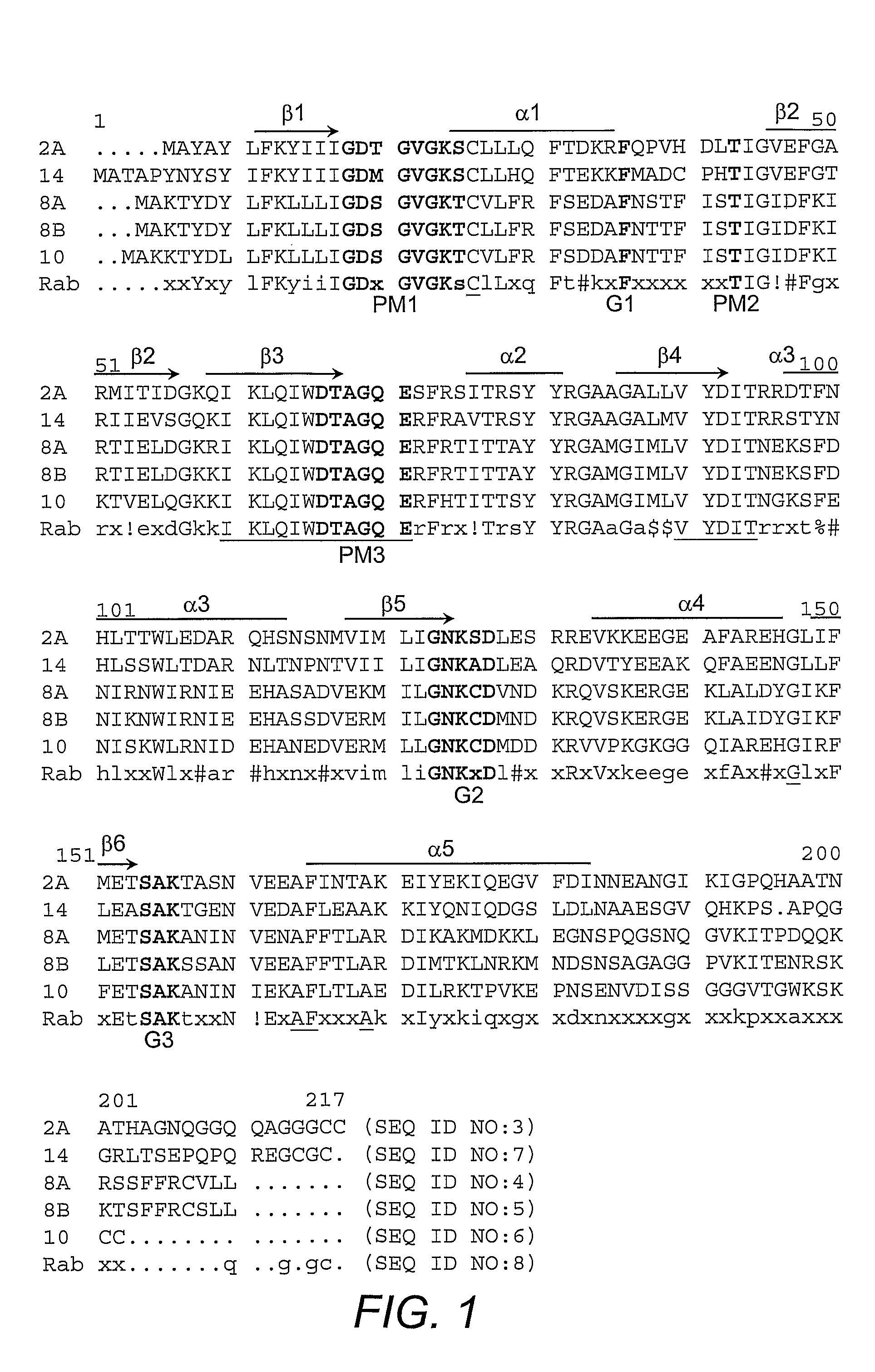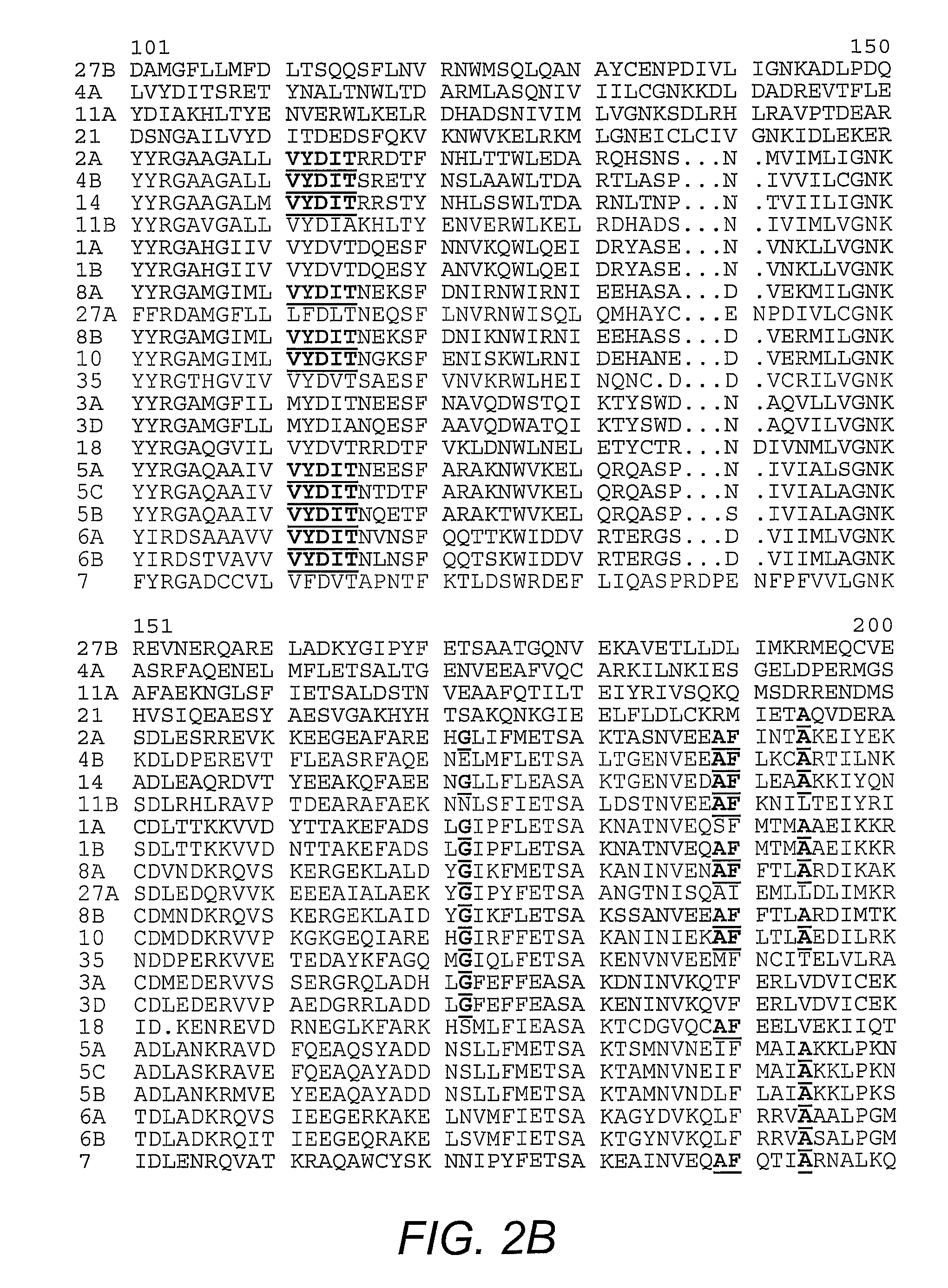Method for identifying agents which modulate GTPase activity involved in insulin-stimulated GLUT4 translocation
a technology of gtpase activity and translocation, which is applied in the field of identifying agents which modulate gtpase activity involved in insulin-stimulated glut4 translocation, can solve the problem of ineffective non-phosphorylation of mutants
- Summary
- Abstract
- Description
- Claims
- Application Information
AI Technical Summary
Benefits of technology
Problems solved by technology
Method used
Image
Examples
example 1
Plasmids
[0041]Plasmids harboring nucleic acids encoding human Rab1A, human Rab4A, human Rab5A, human Rab6, dog Rab7, dog Rab11A, mouse Rab11B, and human Rab21, are well-known in the art. The pGEX plasmids for mouse Rab3A, human Rab4B, dog Rab8A, human Rab10, mouse Rab14, human Rab18, mouse Rab27A, mouse Rab27B, and human Rab35 were prepared by PCR amplification of the Rab coding sequences with templates from several sources, followed by ligation into the PGEX vector. Plasmids encoding N-terminal FLAG®-tagged AS160 and the R973K mutant are known in the art (Kane, et al. (2002) supra). The pGEX plasmids for the GAP domain of AS160 and the R973K mutant GAP were generated by PCR amplification of the DNA encoding GAP domain (i.e., amino acid 865-1299 of human AS160; GENBANK Accession No. gi7662198; Kurihara, et al. (2002) Genomics 79(2):154-161) and ligation into the vector.
example 2
Antibodies
[0042]Antibody to Rab 2 was purchased from Santa Cruz Biotechnology (Santa Cruz, Calif.). Antibody to Rab 8, which reacts with both Rab 8A and 8B, was obtained from BD Transduction Laboratories (San Jose, Calif.). The antibodies against the carboxy-terminus of GLUT4 and the cytoplasmic domain of IRAP are known (Calderhead, et al. (1990) J. Biol. Chem. 265:13800-13808; Keller, et al. (1995) J. Biol. Chem. 270:23612-23618). An antibody against a peptide corresponding to amino acids 167-183 of mouse Rab 14 was generated by immunization of rabbits with the conjugated peptide (Biosource International, Camarillo, Calif.) followed by affinity purification on the immobilized peptide. An antibody against a peptide corresponding to amino acids 171-186 of mouse Rab10 was generated by immunization of rabbits with the conjugated peptide (21st Century Biochemicals, Marlboro, Mass.) followed by affinity purification on the immobilized peptide.
example 3
GLUT4 Vesicles
[0043]Isolation of GLUT4 vesicles was according to standard methods (Cain, et al. (1992) J. Biol. Chem. 267:11681-11684), with slight modifications. 3T3-L1 adipocytes in serum-free medium were treated with 160 nM insulin or not for 30 minutes. Cells on a 10-cm plate were washed with phosphate-buffered saline (PBS) and then with buffer A (1 mM EDTA, 225 mM sucrose, 20 mM HEPES, pH 7.4). Cells were then scraped into 1 mL buffer A with protease inhibitors (10 μM each of leupeptin, pepstatin, and EP475) and homogenized at 20° C. Subsequent steps were at 4° C. The homogenate was centrifuged at 16,000×g for 15 minutes, and the supernatant centrifuged again at 48,000×g for 15 minutes. The supernatant from the second centrifugation, which is a low density microsome / cytosol fraction, was made 100 mM in NaCl and then incubated for 2 hours with anti-GLUT4 or control rabbit immunoglobulin bound to PANSORBIN® (Calbiochem, San Diego, Calif.) (10 μg antibody on 4 μL PANSORBIN® per mL...
PUM
| Property | Measurement | Unit |
|---|---|---|
| pH | aaaaa | aaaaa |
| volume | aaaaa | aaaaa |
| density | aaaaa | aaaaa |
Abstract
Description
Claims
Application Information
 Login to View More
Login to View More - R&D
- Intellectual Property
- Life Sciences
- Materials
- Tech Scout
- Unparalleled Data Quality
- Higher Quality Content
- 60% Fewer Hallucinations
Browse by: Latest US Patents, China's latest patents, Technical Efficacy Thesaurus, Application Domain, Technology Topic, Popular Technical Reports.
© 2025 PatSnap. All rights reserved.Legal|Privacy policy|Modern Slavery Act Transparency Statement|Sitemap|About US| Contact US: help@patsnap.com



